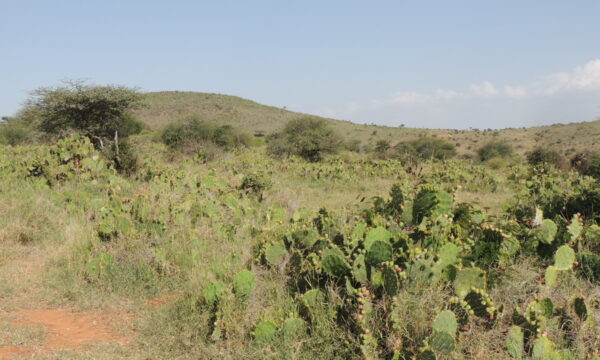By Shenggen Fan, Sivan Yosef, and Rajul Pandya-Lorch
The Sustainable Development Goals (SDGs) have launched a race to transform our world for the better little more than a decade from now. The goals are idealistic, setting a high bar for every aspect of quality of life, from health and education to gender equality and climate action. SDG2 seeks to eliminate global hunger by 2030. But as we move closer to that deadline, achieving SDG2 seems further away. Recent years have been particularly disheartening, with the number of undernourished people continuing to rise annually. In 2015, there were 784 million hungry people in the world; in 2016, 804 million; and in 2017, the most recent year for which data was available, that number reached 821 million people. Adult obesity also continues to worsen in rich and poor countries alike: More than 1 in 8 adults, or 672 million people around the world, are now considered obese.

A woman examines and sorts iron beans in Rwanda. Nutrition-sensitive agricultural programs, such as biofortification or homestead food production systems, may be well suited for increasing people’s consumption of high-quality diets. Photo courtesy of IFPRI (Mel Oluoch/HarvestPlus)
Such trends could justify pessimism or, even worse, paralysis in addressing malnutrition. Yet for the past decade, a fast-growing community of researchers, policymakers, and program implementers has been working tirelessly with the hopes of reversing the tide by 2030 (see Chapter 1). The linchpin of their efforts is the vast potential of agriculture to improve nutrition. After all, agriculture feeds the booming global population, employs most of the world’s poor people, and impacts the environment in numerous (and often negative) ways. Transforming the global food and agricultural system into an equitable, healthy, and sustainable one may just be the big step needed to eliminate hunger and malnutrition in a bit more than 10 years.
During the past few years, this agriculture-nutrition community has made great strides. Researchers have homed in on the importance of diversifying diets through agricultural production and the conservation of agrobiodiversity (see Chapter 4). Evaluations of biofortification efforts in Uganda and Mozambique have found high adoption rates among farmers, higher inclusion of vitamin A in diets of women and children, and in Uganda, improvement of children’s vitamin A status (see Chapter 5). More and more technologies are available to help make agriculture more sustainable, especially as climate change threatens the large-scale production of nutritious crops (see Chapter 7). Researchers have also identified weaknesses in study designs and methodologies that, once addressed, can improve the evidence base on agriculture-nutrition linkages. These lessons are charting the way for high quality program evaluations within the next decade that can better inform agricultural and nutrition investments (see Chapter 9). The potential is enormous.

A man sells produce from a boat in Bangladesh. Rice remains central to the country’s agriculture sector and comprises the majority of what people consume. However, many Bangladeshis are slowly beginning to diversify their diets. Photo: CC BY-SA 2.0, David Brewer
Agriculture-nutrition policy has also been proliferating in various countries. For example, China’s National Nutrition Plan focuses on the production of nutritious and safe agricultural products. Nutrition is also now included in its No. 1 Central Document, which has traditionally focused only on agricultural and rural development (see Chapter 19). In 2015, Bangladesh passed its own National Nutrition Policy, which promotes dietary diversity through nutrition-sensitive agriculture, including behavior change communication and food fortification (see Chapter 15).
There has also been progress within regional policy circles. The African Union Commission and New Partnership for Africa’s Development (NEPAD), for example, engaged hundreds of stakeholders from the Comprehensive Africa Agriculture Development Programme (CAADP) in a Nutrition Capacity Development Process in 2013. The end result was roadmaps for 48 countries that lay out how CAADP investment plans can integrate nutrition within their objectives, targeting, implementation, communication, and evaluation. Just this month, African leaders launched a Continental Accountability Scorecard for Nutrition, which offers a snapshot of various nutrition indicators, and measures the progress associated with nutrition-specific and nutrition-sensitive interventions, the policy environment, and financing.
The last piece of the agriculture-nutrition puzzle is programming. Integrated agriculture-nutrition interventions have the potential to positively impact real people and communities in developing countries. Organizations large and small have begun integrating agriculture and nutrition within their strategies, operations, and evaluations (see Chapter 1). The UN Food and Agriculture Organization (FAO) released a synthesis of guiding principles on agriculture programming for nutrition, and USAID’s Feed the Future has been implementing agriculture-nutrition programming in 19 countries. Many smaller organizations are now using dietary diversity scores, which give a fuller picture of nutrition status, to evaluate their impact. Women’s dietary diversity scores are also being used, as is the Women’s Empowerment in Agriculture Index, illuminating the vital role that women play in agriculture and nutrition (see Chapter 6).
These are just a few snapshots of the progress made by the agriculture-nutrition community during the past decade. While many knowledge gaps about the nature of agriculture-nutrition links still exist, this dedicated community has generated more than enough momentum to incrementally grow the evidence base, produce sound recommendations for policymakers, and monitor and evaluate integrated programming. These efforts are critical to reshaping the agricultural and food system, and to achieving SDG2 by 2030.
This post was originally published on the IFPRI blog.

Shenggen Fan, Sivan Yosef, and Rajul Pandya-Lorch are editors of Agriculture for Improved Nutrition: Seizing the Momentum, published by CABI and IFPRI in January 2019. This title is also available as an Open Access eBook.
Related News & Blogs
Biodiversity loss: How can we reclaim our landscapes from threats to biodiversity?
On 22nd May, we mark the International Day for Biological Diversity. In this article, CABI’s Global Director for Invasive Species Dr Hariet Hinz looks at how we can reclaim our landscapes from threats to biodiversity. Biodiversity loss is proceeding at…
22 May 2025




